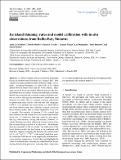Ice island thinning : rates and model calibration with in situ observations from Baffin Bay, Nunavut
Date
24/03/2020Metadata
Show full item recordAbstract
A 130 km2 tabular iceberg calved from Petermann Glacier innorthwestern Greenland on 5 August 2012. Subsequent fracturing generated manyindividual large “ice islands”, including Petermann ice island (PII)-A-1-f, which drifted between Nares Strait and the North Atlantic.Thinning caused by basal and surface ablation increases the likelihood thatthese ice islands will fracture and disperse further, thereby increasing therisk to marine transport and infrastructure as well as affecting thedistribution of freshwater from the polar ice sheets. We use a uniquestationary and mobile ice-penetrating radar dataset collected over fourcampaigns to PII-A-1-f to quantify and contextualize ice island surface andbasal ablation rates and calibrate a forced convection basal ablation model.The ice island thinned by 4.7 m over 11 months. The majority of thinning (73 %) resulted from basal ablation, but the volume loss associated withbasal ablation was ∼12 times less than that caused by arealreduction (e.g. wave erosion, calving, and fracture). However, localizedthinning may have influenced a large fracture event that occurred along asection of ice that was ∼40 m thinner than the remainder ofthe ice island. The calibration of the basal ablation model, the first knownto be conducted with field data, supports assigning thetheoretically derived value of 1.2×10−5 m2∕5 s−1/5 ∘C−1 to the model's bulk heat transfercoefficient with the use of an empirically estimated ice–ocean interfacetemperature. Overall, this work highlights the value of systematicallycollecting ice island field data for analyzing deterioration processes,assessing their connections to ice island morphology, and adequatelydeveloping models for operational and research purposes.
Citation
Crawford , A J , Mueller , D , Crocker , G , Mingo , L , Desjardins , L , Dumont , D & Babin , M 2020 , ' Ice island thinning : rates and model calibration with in situ observations from Baffin Bay, Nunavut ' , The Cryosphere , vol. 14 , no. 3 , pp. 1067-1081 . https://doi.org/10.5194/tc-14-1067-2020
Publication
The Cryosphere
Status
Peer reviewed
ISSN
1994-0416Type
Journal article
Description
Funding: Instrument development and fieldwork were supported by the Northern Transportation Adaptation Initiative of Transport Canada, the Polar Knowledge Canada Safe Passage project (no. 1516-065), and Polar Knowledge Canada's Northern Scientific Training Program. Anna J. Crawford received personal funding from the Garfield Weston Foundation, the Natural Sciences and Engineering Research Council (Canada), and Environment and Climate Change Canada.Collections
Items in the St Andrews Research Repository are protected by copyright, with all rights reserved, unless otherwise indicated.

